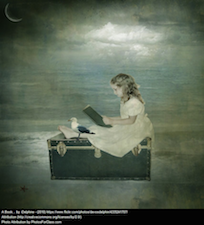4.7 "Show, Don't Tell" and Free Verse
| Site: | Cowichan Valley School District - Moodle |
| Course: | ELA5, CSS, Sferrazza |
| Book: | 4.7 "Show, Don't Tell" and Free Verse |
| Printed by: | Guest user |
| Date: | Tuesday, 30 December 2025, 2:38 PM |
Learning Target
By the end of this lesson, you should be able to say YES to the following questions.
- Can I use language in creative and playful ways to develop style?
- Can I use writing and design processes to plan, develop, and create texts for a variety of purposes and audiences?

Show, Don't Tell - 1
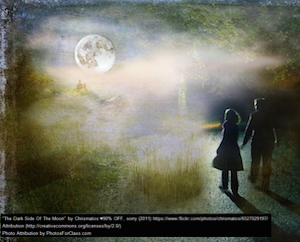 Don’t tell me the moon is shining; show me the glint of light on broken glass.
Don’t tell me the moon is shining; show me the glint of light on broken glass.
– Anton Chekhov
(Source: Goodreads)
What is meant by "Show, Don't Tell"?
You can tell your readers that:
Joe was tired,
or you can show that:
Joe rubbed his eyes and willed himself to keep them open.
You can tell your readers:
It is early spring,
or you can show that:
New buds are pushing through the late frost while the birds are hastily reinforcing their nests.
Show, Don't Tell - 2
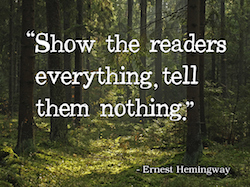
Good writers “show”, rather than “tell”. When you show, you are being an artist, painting with words!
You describe the scenes and actions.
You use clear, specific details to create vivid pictures in our minds.
You use imagery to help us to see, hear, feel, smell, and sometimes even taste.
Show, Don't Tell - 3
Which do you like better?
Jack:
- Telling sentence: Jack was afraid.
- Showing sentence: As the footsteps tapped closer and closer, Jack felt his stomach muscles tighten. He flattened himself to the wall, the gritty bricks against his cheek. Sweat chilled his palms.
Pizza:
- Telling sentence: The pizza was delicious.
- Showing sentence: Mushrooms and pepperoni sausage were layered thickly on top of one another while the white mozzarella cheese bubbled over the bright red tomato sauce. The smell of zesty pepperoni and melted mozzarella made my tastebuds quiver in anticipation.
Show, Don't Tell - Try It!
What are the secrets to "showing" a scene? You learned this in Unit 1!
- Use specific details.
- Use strong action verbs. Enhance them with creatively applied adverbs.
- Use interesting nouns. Describe them with tantalizing adjectives!
- Use imagery to create a picture.
These details breathe life into your writing and project the reader into the scene and become a part of it.
In your Learning Guide, in Show, Don't Tell Rewrites, you will rewrite three of the following as "showing sentences" so that they become "telling sentences". Choose from:
- He eats like a horse.
- A student’s life is hard.
- The car was old.
- My room is a mess.
- The streets were crowded.
- Camping is a rewarding experience.

Dog
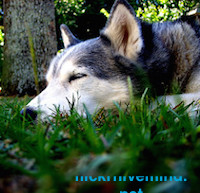 As you explore a new kind of poem and then write one of your own, think about the idea of showing, not telling.
As you explore a new kind of poem and then write one of your own, think about the idea of showing, not telling.
Read through the poem below once. Then, go to your Learning Guide and answer:
- What is the gist of the poem?
Dog - Poem by Valerie Worth
Under a maple tree
the dog lies down,
Lolls his limp
Tongue, yawns,
Rests his long chin
Carefully between
Front paws;
Looks up, alert;
Chops, with heavy
Jaws, at a slow fly,
Blinks, rolls
On his side,
Sighs, closes
His eyes: sleeps
All afternoon
In his loose skin.

Structure
Does the poem rhyme?
When a poem doesn’t rhyme, it is called free verse.
Does the poem have stanzas?
- Free verse poems may be written in stanzas, but not always. The poem, Dog, has no stanzas.
So what about the structure?
- The lines are part of the structure. Some free verse poems have stanzas that are part of the structure.
- The punctuation is also part of the poem’s structure. How to read free verse poems is less obvious than the poems you’ve studied so far and the punctuation helps with this!
Listen carefully to the poem aloud and notice where the pauses are.
Reading Free Verse Poems
What do you notice about how the poem is read?
- The pauses are not at the end of the lines.
- The pauses are directed by the punctuation: commas, semicolons, colon, and period.
- Even though the poem is written in short lines, the lines do not tell the reader where to pause.
In poetry, the punctuation tells the reader how to read the poem.
The poem is in your Learning Guide under Read Aloud. Practise reading it aloud a few times.
- Use the punctuation to guide your pauses.
-
- Expression and volume - Can you adjust your volume and tone of voice to show emotion and/or mood?
- Clarity and Enunciation - Can you speak (articulate) clearly, with good pronunciation so each word can be understood?
- Pace / Fluency – Can you speak smoothly and fluently, with few hesitations?
Before coming back to this online lesson, underline any phrases that “show” rather than tell. Then, return to this online lesson book.

Lines
So how does a poet decide where one line ends and another one begins? A poet thinks about key words and phrases that should have their own lines.
- Look out your window and think of a sentence that describes what you see.
- Now, split your sentence into words and phrases that you can separate into lines.
Wahoo! You have done it! You have thought of a free verse poem. Playing with words can be fun!!!
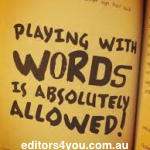
Context Clues
Almost the entire poem "shows", rather than telling. This helps the reader to really "see the dog".
Before you write your own free verse poem that shows, rather than tells, let's do a quick review of context clues. Do you remember learning about context clues? Can you use context clues to figure out what the word loll in the poem likely means?
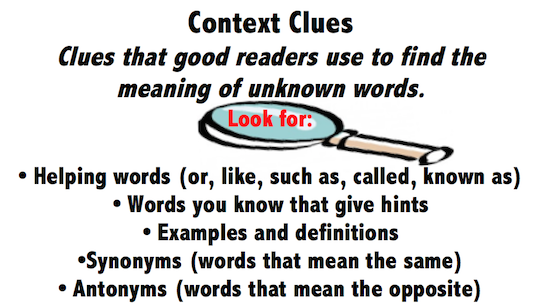
What clues are around “lolled” that can help us to figure out what it means? The dog lies down, yawns, and rests his head. What do dogs tongues do when they are laying down under a tree resting?
Your Turn
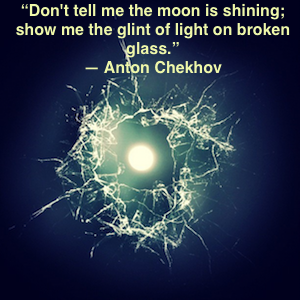
In this lesson, you've learned:
- free verse poems do not have a specific structure.
- free verse poems do not rhyme.
- punctuation guides how a free verse poem is read, rather than lines.
- imagery and showing words create powerful "showing" images.
Now, it is your turn to use these skills in a free verse poem of your own. As you go through the remainder of this online lesson, work in your Learning Guide to complete your poetry writing task.

Pre-Writing

In your Learning Guide,
- Think about a pet you have had OR an object that is special to you.
- Brainstorm three places your pet or object may be found and the moods and positions your pet or object may be in in each situation.
- Brainstorm and record a list of at least 6 words and/or phrases you could use to describe your pet OR object in each situation (HINT: think about imagery, words that help a reader see, hear, feel, smell, and taste what is being described). Add some strong verbs (action words) or verb phrases (similar to the dog that yawned, chopped, blinked, rolled, etc.) that tell how your pet or object would act or what your pet or object would “do” in different situations. Remember to show – don’t tell.
Drafting

Use the words and phrases you brainstormed to write a free verse poem with at least five lines that will help your reader imagine your pet OR chosen object. Remember, it is free verse so it doesn’t rhyme. Be sure to "show, don't tell" by using vivid verbs (action words) and sensory imagery (sights, sounds, smells, tastes, touch).
Revising

Make changes to improve your writing. While making this changes, think VOICE:
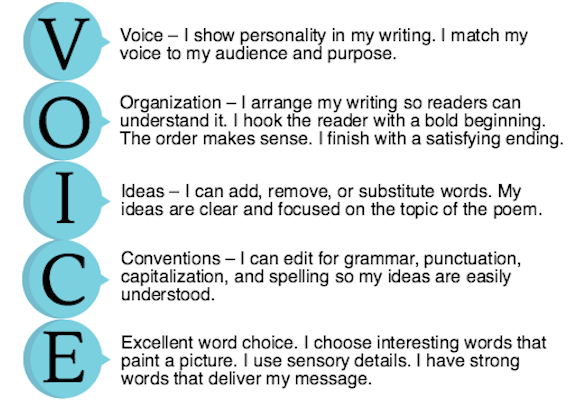
Editing

- Patrol your writing for CUPS. Make changes as needed.
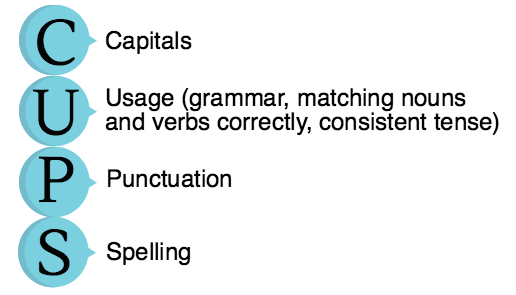
Next Steps
 The next step in the writing process is "Evaluating". In your Learning Guide, think and talk about the evaluating questions with your home facilitator. Decide how well you think your rough draft meets the criteria. Revise and edit your poem more, if you feel it is needed.
The next step in the writing process is "Evaluating". In your Learning Guide, think and talk about the evaluating questions with your home facilitator. Decide how well you think your rough draft meets the criteria. Revise and edit your poem more, if you feel it is needed.

 The last step is "Publishing". This step will be saved for project choices at the end of the poetry unit. For now, this lesson and poem are completed. Congratulations!
The last step is "Publishing". This step will be saved for project choices at the end of the poetry unit. For now, this lesson and poem are completed. Congratulations!

Do you have someone you can share your poem with now?
Reminder
Try to find some free verse poems to read independently. Then, add to your poetry reading journal to show your independent reading reflections.
